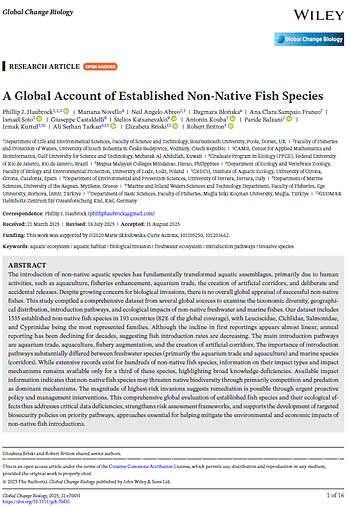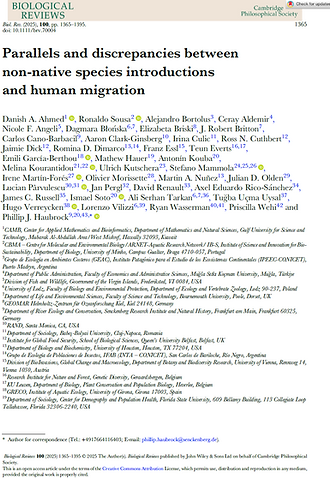Haubrock et al., 2025: A Global Account of Established Non-Native Fish Species, Global Change Biology
Invasive species are widely recognized as a driver of ecological disruption, yet comprehensive global syntheses remain rare—particularly for fishes, which are among the most deliberately and repeatedly moved taxa worldwide. In A Global Account of Established Non-Native Fish Species (Haubrock et al., 2025), published in Global Change Biology, the authors deliver the first rigorous worldwide inventory of established non-native fishes, assembling a dataset of 1,535 species across 193 countries and 204 families. This unprecedented scope enables a nuanced appraisal of their distribution, introduction pathways, and ecological consequences, while highlighting persistent blind spots in invasion science.
The study reveals that freshwater species are disproportionately introduced through aquaculture and the aquarium trade, whereas marine introductions are strongly linked to artificial corridors such as the Suez Canal. Despite the near-linear increase in species first reports since the 19th century, annual reporting rates have declined, suggesting possible saturation, management effects, or under-reporting. Notably, the United States, Mexico, China, and Israel rank among the most invaded nations, with marked biogeographic patterns reflecting climatic compatibility and historical trade routes.
Impact data, however, are strikingly incomplete. While competitive exclusion and predation emerge as dominant mechanisms, detailed ecological, economic, and social assessments exist for only about a third of established species. This knowledge gap is especially acute in the Global South, where monitoring and reporting infrastructures remain limited. The authors argue that without improved coverage, invasion risks will continue to be underestimated, leaving ecosystems and economies vulnerable.
By consolidating disparate records into the Global Fish Invasion Database (GFID), this work provides a critical foundation for risk assessment, management, and policy design. Its central message is clear: mitigating the escalating impacts of fish invasions requires proactive, pathway-focused biosecurity measures and a renewed commitment to global data standardization. In mapping both what we know and what remains obscure, the study sets a new benchmark for understanding the planetary scale of aquatic invasions.

Ahmed et al., 2025: Scholarly discourse in polarizing interdisciplinary contexts, BioScience
In a climate where complex global challenges increasingly demand collaboration across disciplines, the quality of scholarly discourse becomes as important as the research itself. Our original article, Ahmed et al. (2025), addresses the risks of conflating biological invasions with human migration—a parallel that, if applied uncritically, can have serious socio-political and ethical consequences. Drawing on an exceptionally diverse team of more than 40 authors from 23 countries, spanning natural sciences, social sciences, and humanities, the article examines the conceptual, linguistic, and historical pitfalls of such analogies, urging nuance, clarity, and epistemic honesty in interdisciplinary work.
Prompted by a critique from South et al. (2025) that selectively quoted and misrepresented our original arguments, we used our BioScience response to both correct the record and reflect more broadly on the responsibilities of academic engagement in contentious fields. We stress that our work explicitly cautiones against viewing human migration through the lens of biological invasions, grounding this position in historical evidence, ethical reasoning, and philosophical traditions from Aristotle to Kant. We further warn that distorting scholarly arguments—whether through selective citation or ideological framing—risks undermining academic freedom, discouraging interdisciplinary inquiry, and enabling rhetorical “gatekeeping” under the guise of ethical concern.
By reaffirming our commitment to respectful and rigorous scholarly exchange, our work ultimately highlights a core challenge in today’s research ecosystem: how to navigate sensitive interdisciplinary issues without compromising the integrity of debate. Our message is clear—progress depends on disagreement conducted in good faith, with an unwavering commitment to accuracy, transparency, and mutual respect.

Haubrock et al., 2025: To fill or not to fill: Comparing imputation methods for improved riverine long-term biodiversity monitoring, Journal of Applied Ecology
In an era of increasingly data-driven ecology, where large-scale biodiversity datasets are fundamental to informing conservation and management, the treatment of missing data has profound implications for the integrity of ecological inferences. This study is both timely and critical, as it scrutinizes the consequences of a common yet underexamined practice: the imputation of gaps in long-term biodiversity monitoring datasets.
In To fill or not to fill: Comparing imputation methods for improved riverine long-term biodiversity monitoring (Haubrock et al., 2025), published in the Journal of Applied Ecology, the authors employed more than two decades of river macroinvertebrate monitoring data from Denmark, the Netherlands, and Sweden to systematically assess how missing data—and efforts to fill these gaps—alter biodiversity trend estimates. By introducing artificial gaps and applying multiple imputation strategies, including Predictive Mean Matching, Random Forest, and Random Sampling from observed values, they revealed that even modest levels of missing or imputed data could dramatically distort perceived biodiversity trends. Notably, popular methods such as Predictive Mean Matching sometimes amplified deviations, while Random Forest and simple random sampling approaches were more conservative.
This work highlights an urgent methodological concern: imputation, if misapplied or undertaken without careful evaluation, can generate misleading narratives about biodiversity change, potentially steering policy and management decisions astray. The authors argue for a cautious, context-sensitive approach that rigorously weighs whether to fill data gaps at all, emphasizing transparency about the uncertainties that imputation introduces. By providing a nuanced comparative framework, this study advances more responsible practices in handling ecological time-series data, ultimately supporting more robust and credible biodiversity assessments in an increasingly data-dependent conservation landscape.

Ahmed et al., 2025: Parallels and Discrepancies between Non-Native Species Introductions and Human Migration, Biologial Reviews
In a time when political rhetoric and scientific language increasingly blur, it is more urgent than ever to ensure that academic concepts are not misused to justify harmful ideologies. Our work is timely and essential because it interrogates a disturbing trend: the casual comparison of human migration to biological invasions. These analogies, while superficially tempting, can perpetuate dehumanizing narratives and sow confusion in public discourse.
In Parallels and Discrepancies between Non-Native Species Introductions and Human Migration (Ahmed et al., 2025), published in Biological Reviews, we brought together an interdisciplinary team of scholars from more than 40 institutions across 23 countries to explore how ecological frameworks—particularly those from invasion science—have been metaphorically, and often inappropriately, applied to human migration. Our aim was to interrogate them critically and constructively. The paper thus disentangles the conceptual, historical, and ethical implications of drawing parallels between the movement of species and people, highlighting the risks of oversimplification and the potential for harm when scientific language is misused or decontextualized. We argue for an approach that is attentive to disciplinary boundaries, historical legacies, and sociopolitical consequences. Grounded in both natural and social sciences, our analysis offers a path toward more nuanced, responsible, and reflexive interdisciplinary scholarship—one that supports just and context-sensitive policymaking in a world where both environmental and human mobilities are increasingly politicized.

